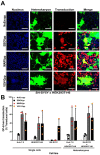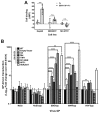Characterization of the Filovirus-Resistant Cell Line SH-SY5Y Reveals Redundant Role of Cell Surface Entry Factors
- PMID: 30893855
- PMCID: PMC6466046
- DOI: 10.3390/v11030275
Characterization of the Filovirus-Resistant Cell Line SH-SY5Y Reveals Redundant Role of Cell Surface Entry Factors
Abstract
Filoviruses infect a wide range of cell types with the exception of lymphocytes. The intracellular proteins cathepsin B and L, two-pore channel 1 and 2, and bona fide receptor Niemann⁻Pick Disease C1 (NPC1) are essential for the endosomal phase of cell entry. However, earlier steps of filoviral infection remain poorly characterized. Numerous plasma membrane proteins have been implicated in attachment but it is still unclear which ones are sufficient for productive entry. To define a minimal set of host factors required for filoviral glycoprotein-driven cell entry, we screened twelve cell lines and identified the nonlymphocytic cell line SH-SY5Y to be specifically resistant to filovirus infection. Heterokaryons of SH-SY5Y cells fused to susceptible cells were susceptible to filoviruses, indicating that SH-SY5Y cells do not express a restriction factor but lack an enabling factor critical for filovirus entry. However, all tested cell lines expressed functional intracellular factors. Global gene expression profiling of known cell surface entry factors and protein expression levels of analyzed attachment factors did not reveal any correlation between susceptibility and expression of a specific host factor. Using binding assays with recombinant filovirus glycoprotein, we identified cell attachment as the step impaired in filovirus entry in SH-SY5Y cells. Individual overexpression of attachment factors T-cell immunoglobulin and mucin domain 1 (TIM-1), Axl, Mer, or dendritic cell-specific intercellular adhesion molecule-3-grabbing non-integrin (DC-SIGN) rendered SH-SY5Y cells susceptible to filovirus glycoprotein-driven transduction. Our study reveals that a lack of attachment factors limits filovirus entry and provides direct experimental support for a model of filoviral cell attachment where host factor usage at the cell surface is highly promiscuous.
Keywords: Filovirus cell entry; SH-SY5Y cell line; attachment factors redundancy; host–pathogen interactions.
Conflict of interest statement
The authors declare no conflict of interest.
Figures








Similar articles
-
Role of EXT1 and Glycosaminoglycans in the Early Stage of Filovirus Entry.J Virol. 2015 May;89(10):5441-9. doi: 10.1128/JVI.03689-14. Epub 2015 Mar 4. J Virol. 2015. PMID: 25741008 Free PMC article.
-
Characterization of Human and Murine T-Cell Immunoglobulin Mucin Domain 4 (TIM-4) IgV Domain Residues Critical for Ebola Virus Entry.J Virol. 2016 Jun 10;90(13):6097-6111. doi: 10.1128/JVI.00100-16. Print 2016 Jul 1. J Virol. 2016. PMID: 27122575 Free PMC article.
-
Calu-3 cells are largely resistant to entry driven by filovirus glycoproteins and the entry defect can be rescued by directed expression of DC-SIGN or cathepsin L.Virology. 2019 Jun;532:22-29. doi: 10.1016/j.virol.2019.03.020. Epub 2019 Apr 3. Virology. 2019. PMID: 30999160 Free PMC article.
-
Filovirus entry: a novelty in the viral fusion world.Viruses. 2012 Feb;4(2):258-75. doi: 10.3390/v4020258. Epub 2012 Feb 7. Viruses. 2012. PMID: 22470835 Free PMC article. Review.
-
Host cell factors in filovirus entry: novel players, new insights.Viruses. 2012 Dec;4(12):3336-62. doi: 10.3390/v4123336. Viruses. 2012. PMID: 23342362 Free PMC article. Review.
Cited by
-
Scrambled or flipped: 5 facts about how cellular phosphatidylserine localization can mediate viral replication.PLoS Pathog. 2022 Mar 4;18(3):e1010352. doi: 10.1371/journal.ppat.1010352. eCollection 2022 Mar. PLoS Pathog. 2022. PMID: 35245334 Free PMC article. No abstract available.
-
Filovirus Antiviral Activity of Cationic Amphiphilic Drugs Is Associated with Lipophilicity and Ability To Induce Phospholipidosis.Antimicrob Agents Chemother. 2020 Jul 22;64(8):e00143-20. doi: 10.1128/AAC.00143-20. Print 2020 Jul 22. Antimicrob Agents Chemother. 2020. PMID: 32513799 Free PMC article.
-
Interdependent Impact of Lipoprotein Receptors and Lipid-Lowering Drugs on HCV Infectivity.Cells. 2021 Jun 29;10(7):1626. doi: 10.3390/cells10071626. Cells. 2021. PMID: 34209751 Free PMC article.
-
The Phosphatidylserine Receptor TIM-1 Enhances Authentic Chikungunya Virus Cell Entry.Cells. 2021 Jul 20;10(7):1828. doi: 10.3390/cells10071828. Cells. 2021. PMID: 34359995 Free PMC article.
-
When Dendritic Cells Go Viral: The Role of Siglec-1 in Host Defense and Dissemination of Enveloped Viruses.Viruses. 2019 Dec 19;12(1):8. doi: 10.3390/v12010008. Viruses. 2019. PMID: 31861617 Free PMC article. Review.
References
-
- Kuhn J.H., Becker S., Ebihara H., Geisbert T.W., Johnson K.M., Kawaoka Y., Lipkin W.I., Negredo A.I., Netesov S.V., Nichol S.T., et al. Proposal for a revised taxonomy of the family Filoviridae: Classification, names of taxa and viruses, and virus abbreviations. Arch. Virol. 2010;155:2083–2103. doi: 10.1007/s00705-010-0814-x. - DOI - PMC - PubMed
-
- Siegert R., Shu H.L., Slenczka H.L., Peters D., Muller G. The aetiology of an unknown human infection transmitted by monkeys (preliminary communication) Ger. Med. Mon. 1968;13:1–2. - PubMed
-
- CDC Outbreaks Chronology: Ebola Virus Disease|Ebola Hemorrhagic Fever|CDC. [(accessed on 13 August 2018)];2018 Available online: https://www.cdc.gov/vhf/ebola/history/chronology.html.Cdc-Ebola.
-
- CDC Outbreaks Chronology: Marburg Hemorrhagic Fever. [(accessed on 13 August 2018)];2018 Available online: https://www.cdc.gov/vhf/marburg/outbreaks/chronology.html.
Publication types
MeSH terms
Substances
LinkOut - more resources
Full Text Sources
Molecular Biology Databases
Research Materials
Miscellaneous

